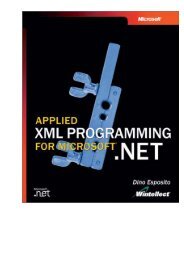I/O Devices and disk scheduling - Csbdu.in
I/O Devices and disk scheduling - Csbdu.in
I/O Devices and disk scheduling - Csbdu.in
Create successful ePaper yourself
Turn your PDF publications into a flip-book with our unique Google optimized e-Paper software.
The actual details of <strong>disk</strong> I/O operation depend on the computer system, operat<strong>in</strong>g<br />
system <strong>and</strong> the nature of I/O channel <strong>and</strong> <strong>disk</strong> controller hardware. When the <strong>disk</strong><br />
drive is operat<strong>in</strong>g, the <strong>disk</strong> is rotat<strong>in</strong>g at constant speed. To read or write, the head<br />
must be positioned at the desired track <strong>and</strong> at the beg<strong>in</strong>n<strong>in</strong>g of desired sector on that<br />
track. Track can be selected us<strong>in</strong>g either mov<strong>in</strong>g-head or fixed-head. On a movable-<br />
head system, the time it takes to position the head at the track is known as seek time.<br />
In either case, once the track is selected, the <strong>disk</strong> controller waits until the appropriate<br />
sector reached. The time it takes to f<strong>in</strong>d the right sector is known as rotational delay<br />
or rotational latency. The sum of seek time, <strong>and</strong> the rotational delay is access time<br />
(the time taken to read or write).<br />
In addition to these times, there are several queu<strong>in</strong>g time associated with <strong>disk</strong><br />
operation. When a process issues an I/O request, it must first wait <strong>in</strong> a queue for the<br />
device to be available. At that time, the device is assigned to the process. If the device<br />
shares a s<strong>in</strong>gle I/O channel or a set of I/O channels with other <strong>disk</strong> drives, then there<br />
may be an additional wait for the channel to be available.<br />
Seek time<br />
Seek time is the time required to move the <strong>disk</strong> arm to the required track. The<br />
seek time consists of two key components: the <strong>in</strong>itial startup time, <strong>and</strong> the time taken<br />
to traverse the tracks. The traversal time is not a l<strong>in</strong>ear function of the number of<br />
tracks but <strong>in</strong>cludes a startup time <strong>and</strong> a settl<strong>in</strong>g time.<br />
Rotational delay<br />
Magnetic <strong>disk</strong>s, other than floppy <strong>disk</strong>s, have rotational speeds <strong>in</strong> the range 400 to<br />
10,000 rpm. Floppy <strong>disk</strong>s typically rotate at between 300 to 600rpm. Thus the average<br />
delay will be between 100 <strong>and</strong> 200 ms.<br />
Transfer Time<br />
The transfer time to or from the <strong>disk</strong> depends on the rotation speed of the <strong>disk</strong> <strong>in</strong> the<br />
follow<strong>in</strong>g fashion:<br />
Where<br />
T=b/rN<br />
T=transfer time<br />
B= number bytes to be transferred















